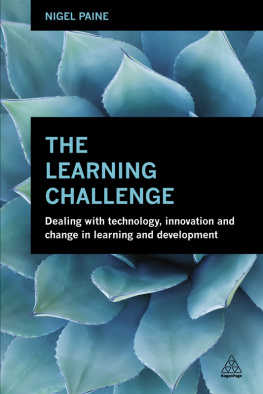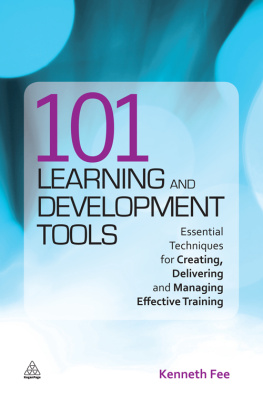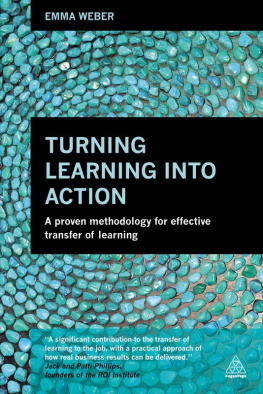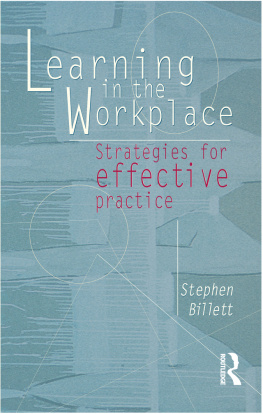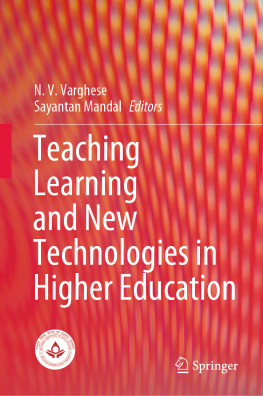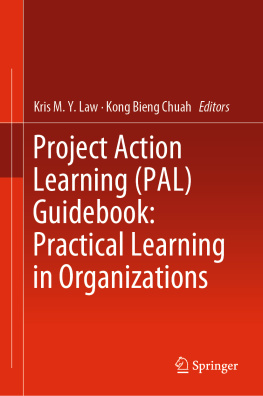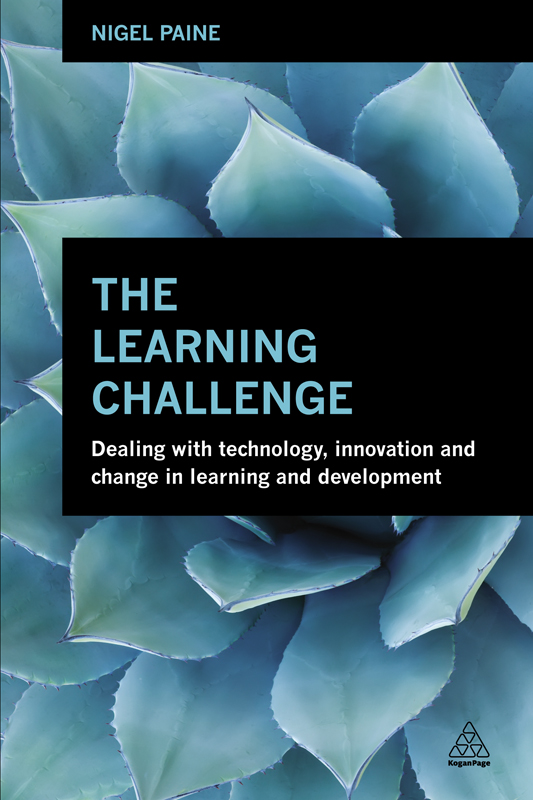Note on the Ebook Edition For an optimal reading experience, please view largetables and figures in landscape mode. |
This ebook published in 2014 by
Kogan Page Limited
2nd Floor, 45 Gee Street
London EC1V 3RS
United Kingdom
www.koganpage.com
Nigel Paine, 2014
E-ISBN 9780749471262
Contents
T here are many people who have helped in one way or another with this book. Their help, inspiration and dedication runs through the pages. I have an image in my head of the person I wrote this book for, but also very strong images of real people working in corporate learning all over the world and doing an excellent job quietly and thoroughly. They represent the future of corporate learning and I am deeply grateful for their inspiration and time. Those whom I interviewed I thank for the endless questions they answered, and their practice that they allowed me to observe.
Specifically I would like to thank some of those people individually: Ben Betts, Sam Burrough, Dr Celine Mullins, Stephanie Dedhar, Alison Shea, Stefanie Moring, Katharine Revel, Sharon Claffey Kallouby, Bob Mosher, Kenny McFee, Charles Jennings, Andrew Jacobs, Cheryle Walker, Dr Robert Demare, Dr J Keith Dunbar, Nick Shackleton-Jones, Julie Clow, Henry Stewart, Anne-Marie McEwan and Traci Fenton. I would also like to thank those who took the time and trouble to comment on first drafts of chapters, particularly on impact measurement: Carol Stroud, Nicole Patterson, Blaine Rada, Jane Botsford, Ruth Haddon, Mike Buttery, Erna Alfred, Nic Laycock, Dr Wendy Green, Dr Urbain Bruyere and Diane Adams.
I took inspiration from the giants in the field like Elliott Maisie, Allison Rossset, Harold Jarche and Robert Brinkerhoff. Also my friendship with Donald Taylor, Sarah Carr, Con Soldatis, Linda English, Susan Metros, Stuart Rosenfeld, Wayne Hodgins, Bob Baker, Dr Doug Lynch, Martin Couzins and many more, has added considerable substance to this book. Of course, its weaknesses I own alone!
I also owe a debt of gratitude to the faculty and current and past students on the University of Pennsylvania CLO Doctoral Program. They really are stars in their own right. Particular thanks to Dr Annie McKee, the Program Director, for her guidance and trust. We have had many great conversations.
The editorial staff at Kogan Page have been unfailingly pleasant and helpful and given good advice. Thank you, Kasia Figiel, Liz Gooster, Katy Hamilton, Nancy Wallace and Anna Moss.
Finally, I would like to dedicate this book to the three women in my life. We are on a learning journey together, and together will take the hills and the rocks in our stride. Thank you Erina, Emily and Sophie for all you have said and the many things still left to say.
I wish I could have read this book when I first began to run a large corporate learning department. It would have been so helpful to have been given a grasp of the overall scope of the role really fast and to have some of the immediate challenges illuminated. Ironically, this book, written for the most part in 2013, looks nothing like the book I would have read eight years previously. Fundamentals are pretty much the same but everything else has shifted dramatically: over half the chapters in this book would have been impossible to write eight years ago and virtually none could sit comfortably with that book from 2004. In some ways the enormity of those changes is another key reason why I felt that it was time to write this book and why I hope that a lot of people will find it not just helpful but essential reading.
There are many shelves of books on aspects of corporate learning but I could find nothing that tries to look across the piece and genuinely feed in information and ideas to flesh out what might be sketchy or illuminate what is unknown. If these books exist, they are well out of date. If you are new to corporate learning then this book will scope your job; if you are already there it will fill in gaps and challenge your thoughts and assumptions. Its modest ambition is to improve the quality, scope and ambition of corporate learning. And it can only do that by promising to:
- make claims that are evidence-based wherever possible;
- use case studies to illustrate abstract concepts or ideas;
- tap into a network of global learning leaders who helped scope the book and check it for accuracy.
This book should be like a personal coach. It will help you take the first steps towards embracing new ideas as well as deliver an in-depth analysis of specific topics. It will ask you questions and help you shape your ideas; each chapter will help you develop your own action plan that bridges the gap between theory and practice or from what should happen to what will happen. But you can also use the book for reference and, if you want to read it from cover to cover, as a continuous narrative. It just depends on what you need and when you need it. The premise is that this book will be useful, or rather essential. It has been written to be a core part of any learning leaders toolkit. You can let me know if I have succeeded.
In we meet Katy on the first day in her new role as Head of Learning and Development. Her case is not atypical: there are many people like her, working on the best way to make the most of their role and have an impact on their organization. If Katys story resonates with your position or describes in part how you feel, this book is very much for you. I know that if Katy had had this book at her side, she would have been able to work out her priorities, develop a strategy, and begin the process of building an L&D operation fit for purpose in the 21st century and fit for purpose in the organization she worked for. I hope you will find it equally useful.
I have divided the book into three parts. Part One sets out the challenges of work and learning, and is a manifesto of sorts for change in learning and the wider workplace. Part Two is rooted in the practical applications of learning in the workplace and covers key areas such as impact measurement and instructional design. Part Three looks at some huge seismic shifts that will impact directly on how we will think about and deliver learning in the workplace. You cannot be a competent and effective learning leader if you have not thought about how what is now known about the brain changes the way you organize learning, or how big data will impact on your analysis of need and monitoring your effectiveness. The technology context is critical now: no learning leader can delegate responsibility for embracing more and more technology in the delivery of learning.
This book can be of general interest to those working in the people sphere in organizations or who want to more clearly understand the imperative for lifelong learning at work. But for those deeply involved in learning at work, it will help you innovate, change direction and vastly improve what you do and how you do it, as well as how you measure your impact. None of this is just what I think: it is based on interviews and discussions with many people involved in learning and the people dimension at work. Many were learning leaders, but some were chief executives and directors of human resources. I owe them all a debt of gratitude for their honesty and frankness, and their input gives me some confidence to say what I have said.
Katy walked into the open plan area that she was going to call home. This was her first day as head of Learning and Development (L&D) and she was excited but slightly nervous. She lifted a hand, in a general way, towards the team and they responded enthusiastically. This was a team under pressure, and a team whose value had not always been appreciated by the rest of the organization; they were looking to the new leader to help. In fact, it was more than help her task was etched in their faces: to save them from extinction!

